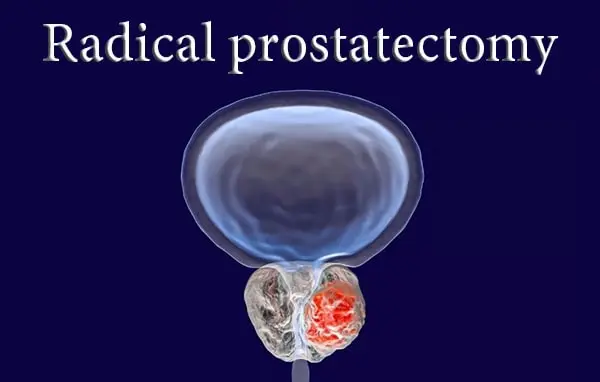Prostatectomy: What to Expect During Surgery and Recovery
Prostatectomy: What to Expect During Surgery and Recovery
What is a prostatectomy?
Surgery to remove the prostate is called a radical prostatectomy. This is a more traditional approach to the treatment of localized prostate cancer. The main goals of a radical prostatectomy are to remove the entire prostate gland and the cancer contained within it, as well as some of the tissue around the gland. Hormone therapy may be given before surgery to shrink the prostate, making the surgery easier. Hormone therapy also can help lower the risk that the cancer will come back or spread to other parts of the body. This is not a common practice for men with early-stage prostate cancer, but it may be an option if hormone therapy is already planned. Consider carefully whether a radical prostatectomy is right for you. This treatment can cure prostate cancer, but it also can cause lasting side effects, such as urinary incontinence and erectile dysfunction. A radical prostatectomy is major surgery from which your body needs time to recover. Older men or those with other serious health problems might not live long enough to benefit from it. This is something you should discuss with your doctors. If you do choose to have a prostatectomy, the next step is to find out what can be expected before, during, and after this surgery.
Who needs to have a prostatectomy?
Prostate cancer comes in many forms, some more aggressive than others. A younger man with many years ahead of him may be best to choose surgery in the hopes that this will be a complete « cure » for his prostate cancer and give him overall good quality and quantity of life after treatment. Surgery may also be the best option for a patient with a longer life expectancy if the cancer is small and contained within the prostate. The decision to have surgery is often more difficult for men with advanced age or other serious medical problems. A man in this situation is more likely to have slow-growing cancer and may not benefit from treatment of any kind. It will be important for these men to understand the long-term outcomes of treatment compared to non-treatment, as well as the potential side effects of any form of treatment.
When prostate cancer is diagnosed, there are a number of treatment options to consider. The best option for each patient depends on the grade and stage of the cancer, as well as the age and general health of the patient. Patients will need to discuss these various treatment options with a number of health professionals, which may include a urologist and/or a radiation oncologist. One of the common treatments for prostate cancer is surgery to remove the prostate, a procedure called radical prostatectomy. This type of surgery is the only way to completely remove the cancer from the body and the surrounding area.
Prostatectomy Surgery Basics
After removal of the prostate gland, prostate-specific antigen (PSA) levels within the bloodstream should become undetectable. Given that the half-life of PSA is around 3 days, it will then take a further 5 half-lives for it to clear the body. This is an important point when considering the early assessment of treatment success with surgery in stopping the disease from recurring. Due to the fact that surgery completely removes the prostate, there is potential for early cure. Moreover, it offers a clear pathological staging, thus identifying the degree of disease within the prostate and allowing an accurate prediction of future disease progression. With the recent increase in life expectancy and the long natural history of the disease, the age of men with early and confined prostate cancer is becoming a more important predictor of treatment choice. Although radical prostatectomy has clear long-term benefits, it also has well-documented side effects including urinary incontinence and impotence, and as a result may not be the best option for all men with localized prostate cancer.
The surgeon removes the entire gland plus some of the tissue around it. Anesthetized patients are given clear instructions about the operation preoperatively and mark the urethra. With the use of laparoscopic technology, which utilizes smaller incisions than those of traditional surgery, the surgeon removes the prostate. Laparoscopic surgery is a promising new technique for the treatment of prostate cancer. Although the underlying concepts of this technique are similar to that of open surgery, laparoscopy involves the use of small abdominal incisions to avoid the need for large open incisions. Small instruments and a lighted tube equipped with a camera are inserted into the incisions. The surgeon is able to view the pelvic anatomy on a video screen and can monitor all aspects of the surgery by carrying out the procedure with the camera and instruments. This new technique offers the advantages of less pain, scarring, and blood loss. In addition, most patients who undergo laparoscopic surgery experience a more rapid recovery and return to normal daily activities within a few weeks, compared to the six to eight weeks after open prostatectomy. Other early concerns are linked to the ability to cure cancer, as well as the recovery of urinary control and sexual function. These two issues have driven treatment decision making in accordance with health-related quality of life for many men diagnosed with prostate cancer, especially when the disease is organ-confined. The strength of prostate cancer surgery is cure and disease control with excellent long-term prognosis. Patients considering surgery will often have long-term expectations and should be counseled with regard to what they can expect in the short term and long term in relation to what the best available current evidence demonstrates.

How many types of prostatectomy are there?
Radical perineal prostatectomy:
This is less common than the retropubic prostatectomy. The surgeon makes an incision (cut) about 10-15 cm long between the anus and the base of the scrotum. This operation is easier and carries less risk of blood loss, but is technically more difficult to remove the lymph nodes, and may cause more problems with controlling bladder and bowel function after the operation.
Standard or retropubic prostatectomy:
In this operation, the surgeon makes an incision (cut) about 15-20 cm long in the lower abdomen below the navel. This can be a disadvantage, as the size of the cut can cause more pain and blood loss, and take longer to recover from. It also increases the risk of more serious complications.Two main types of surgery are used to treat prostate cancer. The choice of surgery may depend on the stage of the tumor, the man’s age, general health and life expectancy, as well as the skill and experience of the surgeon.
Is a prostatectomy a major surgery?
Prostate surgery is not an operation to be taken lightly. Even though you can leave the hospital a few days after the operation, it is a rule of thumb that it’s a good 12 weeks before anyone is near fully recovered. Generally, the more major the operation, the longer the recovery. This is true for all types of prostate surgery. A prostatectomy is the removal of the prostate gland through an incision in the abdomen or through a few small incisions using a robotic arm. In recent years, the use of robotics has increased in prostatectomy, though it is unclear whether this changes the recovery period. Radical prostatectomy is a surgical procedure in which the prostate gland is removed. This operation can be performed in 3 different ways. Open surgery is where an incision is made in the abdomen to remove the prostate. Laparoscopic surgery: several small incisions are made in the abdomen to allow a laparoscope and surgical instruments to be used. This is also known as keyhole surgery. Robotic-assisted laparoscopic prostatectomy (RALP) – this is the same as laparoscopic surgery but the surgeon uses a robotic arm to perform the surgery.
After Prostatectomy: What to Expect ?
After a prostatectomy, you can expect a few changes in your life. First, as long as both nerves were spared during surgery, you should expect your PSA to drop to undetectable levels within 6 weeks. It is important to maintain patience during this time, as it is possible for the PSA to bounce up and down a bit before reaching the undetectable levels. It is important to monitor your PSA following surgery so that adjuvant salvage radiation therapy (radiation given with the idea of curing cancer that was not completely cured with the initial treatment) can be given promptly should your PSA rise again. This gives you the best chance for a complete cure. If the cancer has been completely removed, your PSA should remain at undetectable levels.
During the first month after surgery, most men can only do light activities. As you would expect, your surgical incisions will be sore; therefore heavy lifting, strenuous sports, and long walks should be avoided. It is OK to climb stairs and do light household chores. Bowel effects are a common side effect from surgery that can easily be managed with dietary and lifestyle changes as well as over-the-counter medications. Due to the close proximity of the prostate to the muscles that hold urine, many men suffer urinary incontinence immediately following surgery. Kegel exercises, which strengthen the muscles of the pelvic floor, can be started the day the catheter is removed from the bladder. These exercises can improve or in some cases cure urinary incontinence. If these changes are not helping your incontinence, it is sometimes necessary to see a specialist for physical therapy. Although rare, erectile dysfunction can occur immediately following surgery because of nerve damage. If this change continues past 6-12 months, there are medications and aids that are available to assist in gaining and sustaining an erection. Step 1 is to ensure that there is no longer any sign of cancer with the PSA. At that point, treatment can be started. With time, all of these situations, it is important to remember to not get discouraged. Be patient as changes can improve up to 2 years after surgery.

